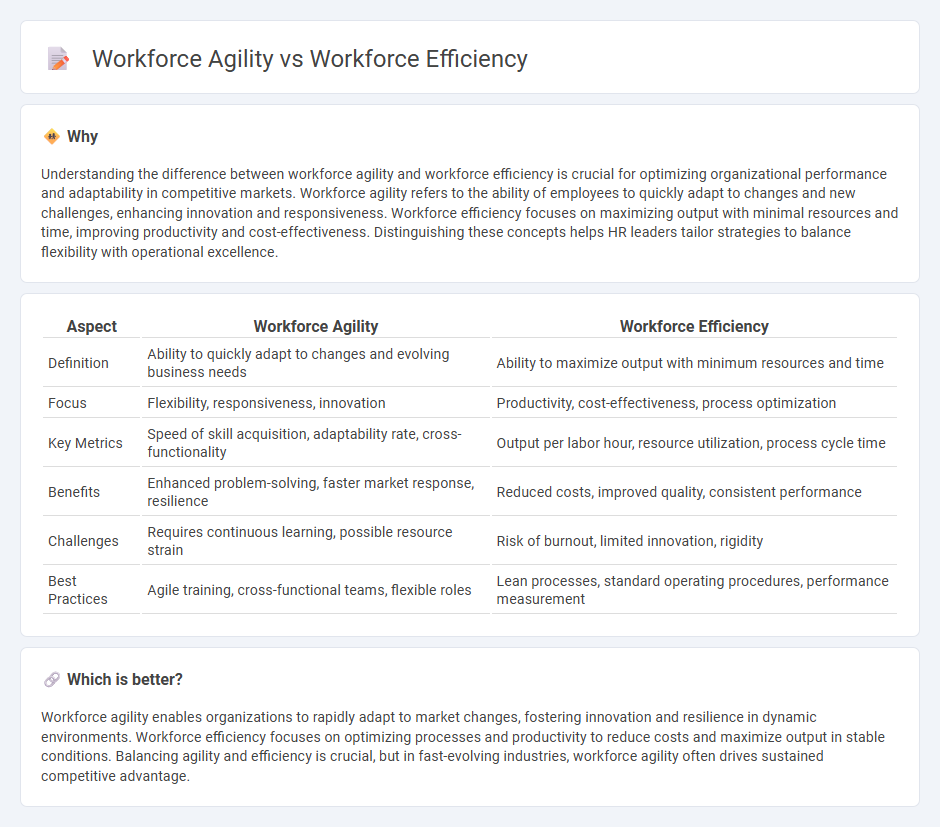
Workforce agility emphasizes rapid adaptability and continuous learning to respond effectively to changing market demands, while workforce efficiency focuses on optimizing productivity and minimizing resource waste through streamlined processes. Balancing agility and efficiency enables organizations to maintain competitive advantage by fostering innovation without sacrificing operational excellence. Explore deeper insights into how integrating these strategies can transform your human resources management.
Why it is important
Understanding the difference between workforce agility and workforce efficiency is crucial for optimizing organizational performance and adaptability in competitive markets. Workforce agility refers to the ability of employees to quickly adapt to changes and new challenges, enhancing innovation and responsiveness. Workforce efficiency focuses on maximizing output with minimal resources and time, improving productivity and cost-effectiveness. Distinguishing these concepts helps HR leaders tailor strategies to balance flexibility with operational excellence.
Comparison Table
| Aspect | Workforce Agility | Workforce Efficiency |
|---|---|---|
| Definition | Ability to quickly adapt to changes and evolving business needs | Ability to maximize output with minimum resources and time |
| Focus | Flexibility, responsiveness, innovation | Productivity, cost-effectiveness, process optimization |
| Key Metrics | Speed of skill acquisition, adaptability rate, cross-functionality | Output per labor hour, resource utilization, process cycle time |
| Benefits | Enhanced problem-solving, faster market response, resilience | Reduced costs, improved quality, consistent performance |
| Challenges | Requires continuous learning, possible resource strain | Risk of burnout, limited innovation, rigidity |
| Best Practices | Agile training, cross-functional teams, flexible roles | Lean processes, standard operating procedures, performance measurement |
Which is better?
Workforce agility enables organizations to rapidly adapt to market changes, fostering innovation and resilience in dynamic environments. Workforce efficiency focuses on optimizing processes and productivity to reduce costs and maximize output in stable conditions. Balancing agility and efficiency is crucial, but in fast-evolving industries, workforce agility often drives sustained competitive advantage.
Connection
Workforce agility enhances an organization's ability to rapidly adapt to changing market demands, directly boosting workforce efficiency by optimizing task allocation and reducing downtime. Agile employees equipped with versatile skills can seamlessly transition between projects, increasing productivity and minimizing bottlenecks. This dynamic interplay between agility and efficiency drives sustained competitive advantage and operational excellence in human resources management.
Key Terms
Productivity
Workforce efficiency measures how well employees complete tasks using available resources, emphasizing streamlined processes and minimizing waste to boost productivity. Workforce agility reflects the ability of teams to quickly adapt to changing demands and innovate, which sustains productivity under dynamic conditions. Explore strategies to balance efficiency and agility for maximizing overall workforce productivity.
Flexibility
Workforce efficiency emphasizes maximizing productivity through standardized processes and stable workflows, while workforce agility prioritizes flexibility to adapt quickly to changing business demands and market conditions. Flexible workforce strategies include cross-training employees, implementing flexible work schedules, and leveraging technology to maintain responsiveness without sacrificing output quality. Explore how balancing efficiency and agility can transform your workforce for sustained competitive advantage.
Adaptability
Workforce agility centers on adaptability, enabling teams to respond swiftly to market changes and evolving business demands, whereas workforce efficiency emphasizes optimizing current processes for maximum output. Agile workforces leverage cross-functional skills and continuous learning to pivot seamlessly, driving innovation and resilience in dynamic environments. Explore strategies to enhance adaptability and balance efficiency for sustained organizational success.
Source and External Links
Workforce Efficiency: Definition, Importance & Key Steps - Workforce efficiency is an organization's ability to maximize productivity while minimizing resource consumption, time, and effort, achievable through strategies like process automation and productivity tracking at team and individual levels to optimize utilization and improve outcomes.
Workforce Efficiency: Strategies, Metrics, and Tools for Success - Enhancing workforce efficiency includes using collaboration tools and clear metrics for remote teams, aligning workforce activities with strategic goals via measurable OKRs, and reducing operational costs through staffing optimization and automation.
Workforce productivity - Workforce productivity is measured by the output generated by workers over time and can be maximized through effective time management, employee engagement, and well-being, which together lead to higher organizational performance.
 dowidth.com
dowidth.com